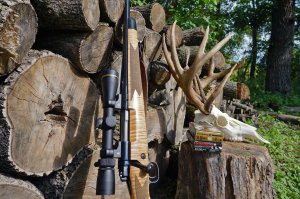A reader submitted a question to our weekly On The Gun newsletter (which you can sign up for here) about how to cope with recoil and cartridge selection.
He described how he’s become recoil shy when using his old Savage 99 in .308 Win. Despite equipping it with a recoil pad, his ability to shoot it accurately has diminished over the years to the point where he doesn’t feel comfortable hunting with it. Even worse, he confesses he no longer enjoys shooting it at all.
Our reader has since switched to an older Marlin .30/30 Winchester that belonged to his father-in-law, which he shoots well, and a heavy-barreled H&R Ultra Slug Hunter (sadly no longer produced) for hunting a shotgun-only zone in Minnesota. Both have reliably put venison in his freezer.
Despite the demonstrably greater recoil of the 12-gauge slug gun, compared to his Savage 99, he finds it easier to manage, and wonders whether there’s anything he can do to overcome the discomfort with his once-beloved .308.
“Is there any advice for how to handle recoil?” he asked. “What can I do to return to using my .308? Do you think it will be possible?”
He then poses a follow-up question. After much research, he’s come to appreciate the virtues of the 6.5 Creedmoor, even though he’s never shot one. At 68 years old, he isn’t looking to expand his gun collection, but he is thinking about getting a rifle that he might later pass down to his son, who could use it for deer and larger game.
“Is the 6.5 Creed sufficient for elk hunting? From what I have read, it seems like it is marginal for a tougher animal like an elk. I am a little torn about what to do.”
Both are excellent questions.
Understanding Felt Recoil
You can plug numbers into a formula to calculate a rifle’s free recoil. After putting in the bullet weight, muzzle velocity, weight of the firearm, and weight of the powder charge in the cartridge, the equation will spit out a recoil value in foot-pounds.
| Cartridge | .223 Rem. | .243 Win. | .30/30 Win. | 6.5 Creed | .308 Win. | .30/06 | .45/70 Gov’t | 7mm Rem. Mag. |
| Recoil Energy (ft-lb.) | 5.1 | 12.3 | 14.2 | 15.7 | 21.2 | 25.2 | 26.3 | 28.6 |
The above are examples of the relative recoil energy of some common cartridges. These were all calculated based on a 7-pound rifle. As you can see, there’s quite a difference between the .30/30 and .308 Win. Everything else being equal, the .30/30 generates just 67 percent of the recoil that a .308 Win. does.
But these numbers don’t tell the whole story. How we experience recoil is influenced mightily by how a firearm is configured.
For instance, an effective recoil pad takes the recoil impulse and, thanks to its squishy construction, distributes it over a longer duration to reduce the felt recoil. A muzzle brake will redirect the gasses from the muzzle blast so that some of the force is expended in a direction other than straight back. This also lessens the recoil we experience. Even better, if those muzzle gasses are directed upward they will reduce the muzzle jump — meaning the stock won’t travel upward into the shooter’s face, which exacerbates felt recoil.
A suppressor can be as effective (or more so) than a brake. It contains and slows down the speed with which the gasses escape the muzzle (spreading the force over a greater length of time). But more importantly, it reduces the shock of the muzzle blast which a brake exaggerates. That shockwave of sound has an outsized impact on how we experience recoil. Even though a brake reduces the physical force our shoulder experiences, the violent sound it creates triggers an instinctual flinch.
How a stock is shaped has an impact on felt recoil as well. Stocks with a lot of drop at the heel, which the Savage 99 has, will tend to pivot up into the shooter’s face and feel more jumpy than a stock with a straight comb. (The significant drop at heel is meant to align the shooter’s eyes with the rifle’s iron sights, so when you put a scope on one and have to lift your head high above the stock, that often makes the recoil feel more severe.)
Managing Recoil
Becoming more sensitive to recoil over the years is not uncommon. Biologically, we’re wired to flinch — the explosive blast, the ear-splitting sound, and the rifle’s slap and kick are all things our lizard brain instinctively (and understandably) seeks to avoid.
One can manage felt recoil with better shooting technique, but that only goes so far. Keeping the recoil pad in firm contact with the shoulder, not pressing our cheek into the stock with excessive force, holding the stock firmly at the grip and fore-end, and squaring our shoulders to the recoil pad will help a shooter manage recoil. Among other things, these pointers keep the beating the shooter’s face experiences to a minimum.
Taming the Savage 99
Now it might be possible for our correspondent to improve the manners of his Model 99 to the point where shooting it becomes a joy again. He can try to mount a scope lower on the receiver (or switch to something like the new Vortex Viper Micro red dot). He can add a raised cheek piece to the butt stock for a better face-to-gun fit. Or he could try to equip it with a muzzle device, or attempt to add weight to the rifle with lead plugs in the stock.
These proposed remedies would all help, but whether they’d tip the scales and bring the rifle back into his good graces is an open question. My guess is that the relationship can’t be repaired.
Being Recoil Shy
There is no shortage of ballistic he-men prowling the Internet and social media. These paragons of masculinity advocate for big cartridges for big game — recoil sensitivity be damned. To their way of thinking, the stout kick generated by a .30-caliber magnum is the price of admission for reliable terminal ballistics on elk, bear, moose, and other game bigger than a whitetail.
They conjure scenarios where an unfavorable shot angle, mud-encrusted hide, or stout shoulder bone can only be ethically overcome with .300 Win. Mag. or its ilk.
The fact that a shooter won’t be able to shoot as well with one of these filling-rattling rounds — in terms of poorer shot placement, an inability to see where the bullet hit (or missed) due to losing the sight picture under recoil, or difficulty getting back on target quickly for a follow-up shot — doesn’t matter to this crowd.
But not all of us were destined to scale Mount Machismo. Fortunately for the pissants among us, a proper understanding of modern terminal ballistics gives reason for encouragement.
On Killing Power
Only two things kill an animal. First, you can destroy the central nervous system (CNS) with a shot to the brain or spine, effectively turning the lights off. Or you can induce blood loss — exsanguination is the fancy term — which deprives the CNS of oxygen, again flipping the light switch.
If your bullet causes enough tissue damage and hemorrhaging to compromise the CNS, it has done its job. Every other metric takes a back seat to this, including bullet diameter, foot-pounds of impact energy, retained bullet weight, etc. Tissue damage is king.
Bullets are designed to upset reliably across a range of impact velocities. If a bullet strikes its target going too fast or is constructed too lightly, it can possibly grenade on impact, resulting in a ghastly but non-fatal wound. Or if it hits the animal too slowly — say 1,600 fps or slower, though this entirely depends on the specific bullet — it might not expand or upset well enough to cause the needed tissue damage.
Fortunately, most of today’s hunting bullets have a forgiving velocity envelope, and the engineering behind them is light-years ahead of what our fathers and grandfathers had available. So smaller bullets, often with high ballistic coefficients, can create excellent tissue damage even at longer ranges.
Two seasons ago, for instance, I killed two bull elk, one with a .300 Win. Mag. (178-grain ELD-X) and the other with a 6.5 PRC (143-grain ELD-X). Both shots were over 600 yards, and both animals died where they stood. I recovered the projectiles under the hide on the offside of each animal.
| Bullet | Shot Distance | Starting Weight | Recovered Weight | Retained Weight | Expanded Diameter |
| Hornady 6.5mm 143 ELD-X | 656 yards | 143 gr. | 107.7 gr. | 75.3% | .553 in. |
| Hornady .308 178-grain ELD-X | 604 yards | 178 gr. | 134.6 gr. | 75.6% | .578 in. |
Not only did these bullets perform exactly as designed, they did so in a nearly identical manner on very similar (broadside) shots. They expanded well at a lower impact velocity (due to the shot distance), penetrated deeply, and retained most of their weight.
Notice the expanded diameter of the bullets. The .308-caliber bullet from the .300 Win. Mag. measured just two-and-a-half hundredths of an inch more than the .264-caliber bullet from the 6.5 PRC. And yet you’ll have people swear up and down that these cartridges are in two different classes — one a manly magnum, and the other a man-bun special.
In fact, by every metric, their terminal performance was identical — penetration, weight retention, bullet expansion, and killing effectiveness. The only difference is in felt recoil and shootability — where the 6.5 PRC has a decided advantage. And for what it is worth, the bull killed by the 6.5 PRC was much larger than the 6×6 elk I took with the .300 Win. Mag.
We’ve seen this dynamic play out again and again, where good bullets from milder cartridges, like the notorious 6.5 Creedmoor, are absolutely deadly on big game, including elk, moose, and bear.
The “Tough” Animal Label

Are elk and moose tough game animals? Certainly. But there’s a mythology that’s been built up around them that overstates how hard they are to kill.
This last fall I encountered two wounded elk. One was a bull that was shot opening day in the backcountry where my buddy, Cody, and I had set up. That morning at first light we heard a fusillade of shots, which is always a bad sign. This was from a group of guided hunters that had passed our camp on horseback in the dark.
We gave that group a wide berth, not wanting to disturb their hunt, but mid-morning as we were working our way up a ridge, I spotted a wounded bull. He’d obviously been hit several times and was standing in a rocky outcropping trying to hide from us.
We backed away from the poor creature, and I made a series of phone calls and was able to get in contact with the guide and tell him where his client’s bull was located.
Later that afternoon they finished him off, and the next day we met up with them as they were packing its quarters off the mountain.
It was the man’s first elk, and he was beyond grateful that we not only found his bull, but that we didn’t tag it ourselves. He was from the Midwest and had purchased a .300 Weatherby for this hunt. He shot from about 300 yards away but despite the Weatherby’s “authority” and reputation as a big game round, his substandard shot placement didn’t kill it.
Now, when an elk is shot by a .300 magnum and it either gets away or is wounded like that, the hunters chalk it up to how “tough” an elk is. But if someone did the same thing with a 6.5 Creedmoor, everyone knows that it’s because that isn’t enough gun!
You see where I’m going with this. The magnum crowd has a self-validating bias that their .300s are ideal for elk, and that should it come up short, that’s because the animal is so tough – rather than placing the blame where it should go, which is that their shot selection and marksmanship skills are not up to snuff and no doubt made worse by their choice in heavy-recoiling firearm.
I’m not saying that a 6.5 Creedmoor in this circumstance is a perfect solution — you can still make a crappy shot with one and wound an animal — but I have little doubt that our Midwestern hunter would have likely been better served shooting a milder cartridge, with a proper bullet, that he could control better. It certainly wouldn’t have performed any worse.
Read Next: Best Elk Hunting Rifles
As for moose, while they are large animals, they aren’t particularly difficult to kill. The many I’ve killed over the years have dropped easily with a .338 Federal, 6.5 PRC, .30/06, .280 Remington, .308 Win., .450 Marlin, and even a .300 Ultra Mag. Almost all presented follow-up shots (other than those that dropped instantly out of sight) as they don’t bolt as quickly as, say, a whitetail will.
Outdoor Life senior staff writer Tyler Freel, who has hunted moose every year for his adult life, concurs. While he doesn’t claim it is the ultimate moose round, he had no problem killing a bull last year with a 22 ARC. With a proper bullet, even a round in that class will settle a bull moose’s hash.

The point is that magnums don’t buy you much (or anything) in terms of killing power over a smaller round. A lousy hit is a lousy hit, and the fact that you’re using a round with “magnum” in its name won’t convince the animal to expire. Shot placement and bullet selection are the key, and there’s no doubt that a milder round, which you’ll practice with more and shoot better, has some critical advantages.
6.5 Creedmoor and Elk
So, yes, the 6.5 Creedmoor is a fine elk cartridge. I’ve killed many elk and other large animals (including African game like giant eland, greater kudu, waterbuck, and other stout critters) with the round, as have many other competent hunters.
Can you wound and lose an animal with a 6.5 Creedmoor? You bet. It’s happened plenty of times. But I doubt many of those animals would have been anchored if the hunter had been using a magnum. And I’m confident that many more animals have been lost because the hunter was using a gun larger than they were able to shoot proficiently, rather than something more in their wheelhouse.
(As an aside, long before the Creedmoor came on the scene, when people would ask me what rifle they should take on their first elk hunt or trip to Africa, I would tell them to use the deer rifle they’re comfortable with. It is still sound advice.)
Read Next: Best 6.5 Creedmoor Rifles
In Conclusion
So, while I think the reader who asked the questions that prompted this screed has done the right thing to switch to his .30/30 for deer and retire his Savage 99, I also support the idea of him investing in a quality 6.5 Creedmoor. If his son, who he plans to eventually give it to, practices with it diligently he can go west on his first elk hunt confident in the knowledge that he is wielding a capable and deadly rifle equal to the task.
Read the full article here





